Discount Set Up: Products
Setting up discounts for products: Six steps to creating discounts.
Prerequisite Permissions: To configure discounts, your user account must be enabled with the permission for Company->Discounts. If you do not have this permission, contact your winery's eCellar User Manager for assistance.
There are several variable discount features, split into 6 sections:
- Start
- Criteria
- Validity
- Basis
- Discount
- Supplemental

Creating A Discount for Product(s)
Navigate to the discount engine via Company-Discounts
Select the Toggle button found next to CREATE NEW DISCOUNT.
1. START
A. Discount Name:
This will appear in the POS and order detail.
Discount Name is identified in POS and web orders. This is especially helpful during testing.
B. Public Name:
This will appear on your web site and receipts.
IMPORTANT: If a Public Name is not present the name of the applied discount(s) will not appear in the web site cart editor summary, nor the side cart.
C. Discount Type: Primary or Supplemental.
Supplemental discounts are a way of "stacking" an additional amount onto an already existing discounts.
Ex. 10% Club Discount is primary and always available. During a particular promotion (period and/or product) club members get and additional 5%. The 5% would be built as a supplemental discount and attached to the primary.
D. Discount Applied to:
Entire order - Discount will apply if the Basis (section 4) is not met.
Line Items - Discount will be applied to line items that match the Basis (section 4).
Shipping Charges - Discounts will be applied to shipping charges only. (See this article for more details.)
E. May be used:
This indicates the number of times the discount can be used - helpful for one-time use only.

2. CRITERIA
A. Who is eligible?
You have 4 different options to choose from:
- Anyone: This will apply the discount to anyone who uses the web or designated in the point of sale.
- First-time-customers: This will apply the discount to anyone who has no prior order history.
- Select Customer Types: When selecting customer types there will be a drop down that will allow you to select which groups you would like to have access to the discount.
- Select Club Members in Select Tiers: When selecting Club Members there will be a drop down that will allow you to select club tiers you would like to have access to the discount.
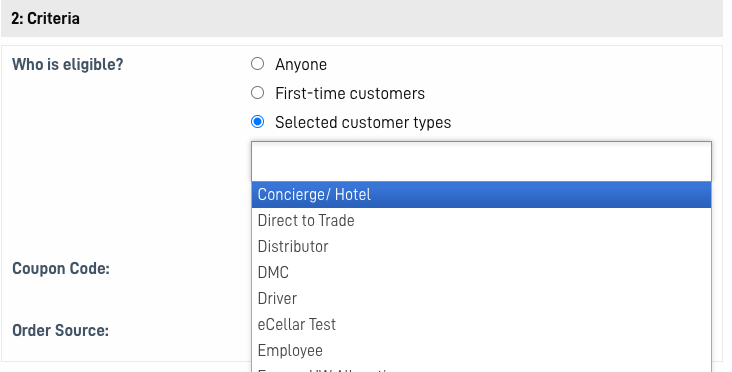
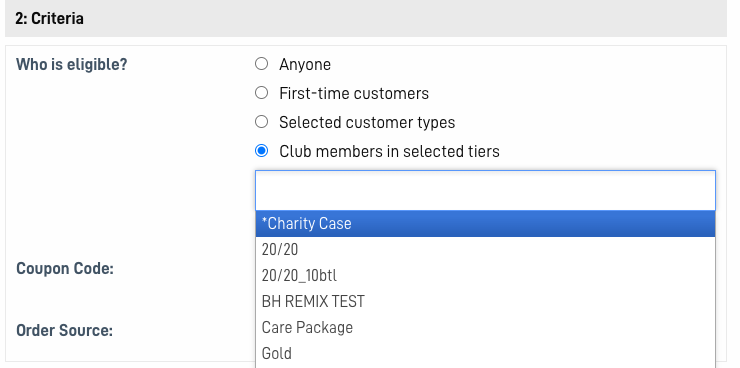
B. Coupon Code
This is only functional in your web site. If a coupon code is present in the discount it will not be active in the POS. Upper or lower case letters are not adhered, either can be used in the web site to apply the discount.
C. Order Source
Allows you to choose specific Order Source(s)/Channel(s) and limit the source to which the discount will apply. More thna one may be selected.

3. VALIDITY
A. Is this Discount Active Now?:
Allows you to enable and disable the discount as needed. Note - only disabled discounts can be deleted (good to know for testing with different discount scenarios!).
Proceed with caution when deleting. Deleted discounts cannot be recovered.
B. Start Date with the option of Now –or- On and/or...
C. End Date with the options of Never –or- On.
These features can be used to place a discount to start immediately, a future date, or limit a discount for a specific time period.

Validity "Best Practices"
- Disable discounts that are not is use.
- Minimizing the number of ACTIVE discounts is important as the system has to weigh each active discount when engaging the engine.
- Many active discounts can cause errors as the platform will look for the BEST discount to offer.
- Disable discounts even if end dates are in place.
- Discounts can be saved and re-enabled/recycled at a later date or deleted.
- A discount can be deleted only if it is disabled.
- Proceed with caution when deleting. Deleted discounts cannot be recovered.
4. BASIS
Basis are are used to "qualify" the discount. AND relate back to box 1 for where the discount will be applied: Line Items or Entire Order.
A. Discount is Triggered By:
Select the radial button to determine how you want to have the discount triggered. Your choices are between total aggregate amount on the order or specific inventory items.
Notice that if you choose Entire Order a check box option appears, "Apply min/max to required products only".
Example: If the basis is entire order, and Min items in order = 6, and the box id UNchecked, the discount will apply to ANY minimum 6 items regardless (Image 1 below). If the box IS checked, the discount will apply to just 6 items as qualified in Required Products (Image 2 below).
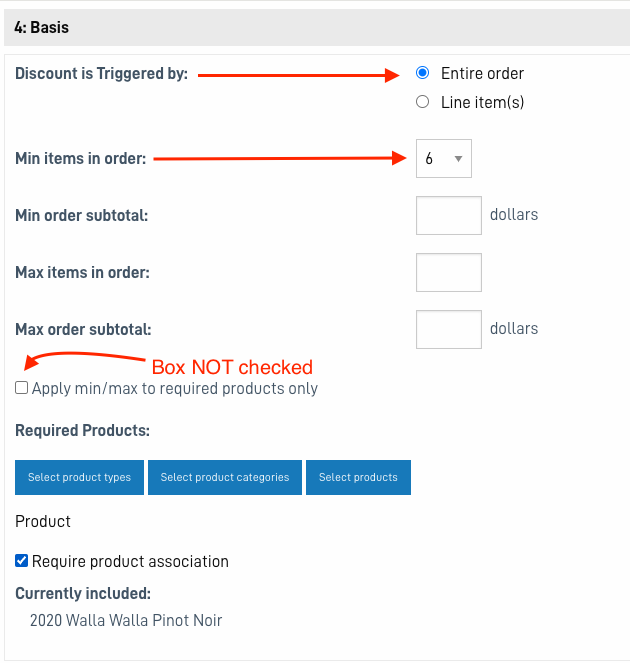
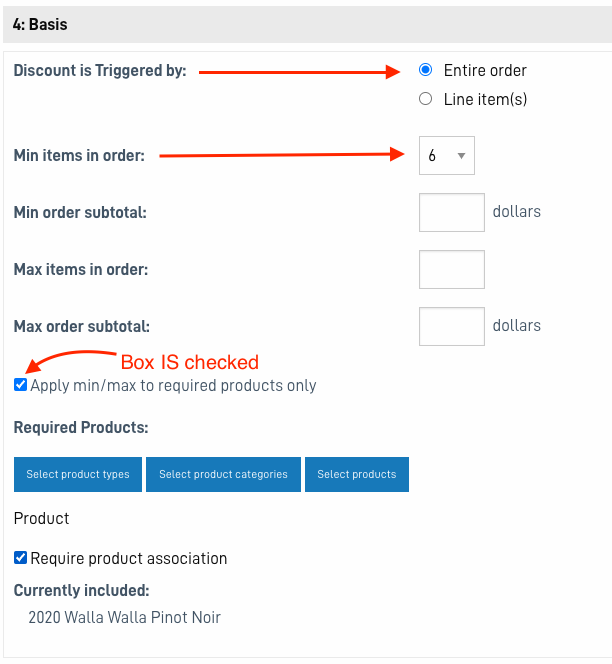
B. Min Items in order:
Choose the minimum item total in the order. The default is one. This box allows for the discount to be triggered by total items.
C. Min Order Subtotal:
Choose the minimum aggregate amount subtotal dollar amount you want the discount to be applied to. This is used in conjunction with the entire order radio button.
D. Max Items in order:
Allows for a cap on the quantity. This can be used in conjunction with a second discount: Discount 1 - Min 1, max 5 at 10%, Discount 2 - 6 or more at 15%.
E. Max order subtotal:
Allows for a cap on the dollar amount.
F. Required Products:
Required Products is used in conjunction with line item radio button. It is here where you can select a specific product, category product, or product type to trigger the discount.
See this article for more details.

5. DISCOUNT
A. Flat Rate/Included
Default is Flat Rate/dollars indicated in green. Toggle to Percentage.
Choose the discount amount. Note, for Supplemental this is in addition to the Primary and not the total. See this article for more information.
B. Fixed/Variable
Use Variable to add cumulative discounts to the basis. Click and brackets can be added by dollar or item quantity increments.
Dollar Example: Bracket 1 - Spend at least $100 dollars on qualified order items and receive $10 off. Bracket 2 - Spend at least $150 dollars more on qualified order items and receive $15 off.
Item Example: Bracket 1 - Buy at least 4 quantity qualified order items and receive 10% or X$ off. Bracket 2 - Buy at least 6 quantity more qualified order items and receive 15% or Y$ off.
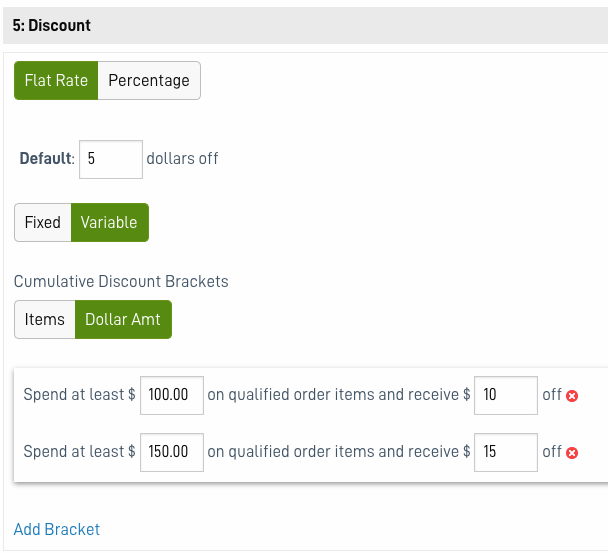
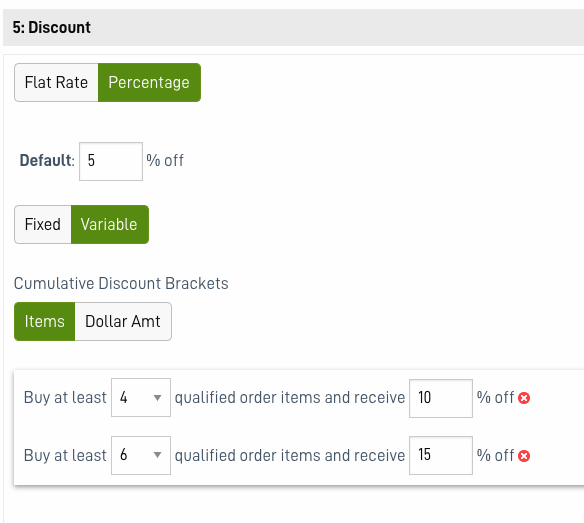
C. Supplemental Discounts:
This section is where Supplemental Discounts are associated with Primary discounts. This section is not available when Supplemental is chosen in section 1. See this article for more details about Supplemental Discounts.
TEST and Test again: We cannot stress enough that testing is key to the success of discounts.
- Include non-discounted items in an order.
- Try more or less than the max/min amounts.
- Use the discount in web and/or POS orders.
Test with different customer types in both the POS and on your web site.
- Try to make it NOT work the way you want it to.
Reach out to Support if you are not getting the results you expect and need assistance
(include discount name and the desired results).
NOTE: The system will select the Primary discount that offers the customer the greatest/highest discount and then applies supplemental discounts. If during testing an errors occurs, looking for conflicting discounts is a good place to troubleshoot.
